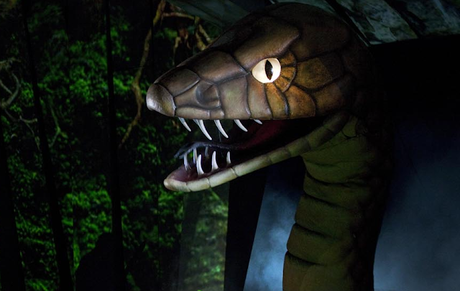by Paul J. Pelkonen

Badger, badger, badger, badger....the dragon Fafner emerges in Act II of Siegfried.
Photo by Ken Howard © 2011 The Metropolitan Opera.
What is Siegfried?
This was intended as the "comic" part of Wagner's Ring, a light-hearted fairy tale about the boyhood and early adventures of the pretty strong but not-too-smart Siegfried. He is the son of the twins Siegmund and Sieglinde, and the opera follows his quest toward independence and maturity, all to ravishing music.
What's the plot?
Siegfried is the story of the title character's growth from adolescence to manhood. Along the way, the naïve (and some would say numb-skulled) young hero re-forges his father's sword tries to learn the meaning of fear, slays a dragon and confronts his grandfather Wotan (now in disguise as the silver-haired Wanderer) in an epic mountaintop showdown. In the opera's climax, our hero wakes, woos and wins Brunnhilde, and the two sing a very long love duet.
How's the music?
Wagner charted each act of this opera as an upward journey, from a dark, brooding minor key to a sunny major. The title role is one of the most punishing ever written for the heroic tenor voice. Siegfried must exert himself, forging his sword, killing the dragon Fafner and climbing up a mountain before waking up the soprano (who has yet to sing a note) and singing for approximately thirty more minutes. Nobody said heroism was easy.
OK. Tell me something else interesting?
The score of Siegfried was written in two parts, with a twelve-year pause so Wagner could write Tristan und Isolde and Die Meistersinger von Nürnberg. The composer's style in Act Three is denser and heavier than what came before, with the themes coming thick and fast as Siegfried nears the end of his quest.
That's all you've got? I thought this was Superconductor!
The music for the final duet was originally written as part of a chamber orchestra work called the Siegfried Idyll, whch Wagner wrote as a combined birthday/Christmas present for his wife Cosima in 1869. The couple were celebrating the birth of their third child and first son. His name? Siegfried, of course.
Who's in it?
The heldentenoren Stefan Vinke and Andreas Schager alternate in the difficult assignment of the title role. Gerhard Siegel is the conniving dwarf Mime, Siegfried's unwilling guardian. Bass-baritone Michael Volle sings the role of the Wanderer. Christine Goerke returns as Brunnhilde. Dmitri Belosselskiy and Tomasz Konieczny sing Fafner and Alberich. Erin Morley will sing the (offstage) role of the Forest Bird.
How's the production?
The nature-paintings of the score are a stiff challenge for Robert Lepage's high-tech vision of the Ring. There's a lot of projected woodland, blowing leaves, flowing digital water and a return of the Magic Fire effect. Fafner is spectacular, a big puppet snake that is birthed menacingly from the depths of the Machine set.
When does it open?
Siegfried takes the stage for three performances on April 13 (at 11:30am!) May 2 and May 9. The latter two are sold as part of complete Ring Cycles. Rush tickets are only available for the April performance.
How do I get tickets?
Tickets are available at metopera.org or call the box office at (212) 362-6000.
If you enjoyed this article, it's time to click over to Superconductor's Patreon page, and help support the cost of independent music journalism in New York City at the low cost of just $5/month.

